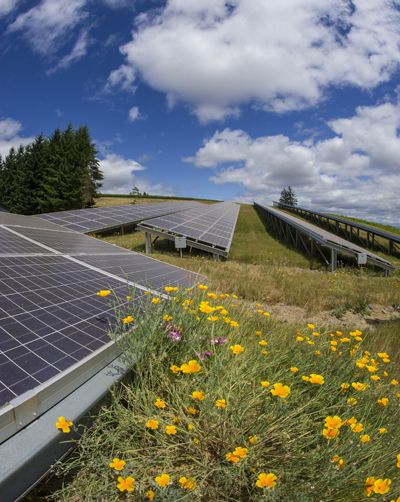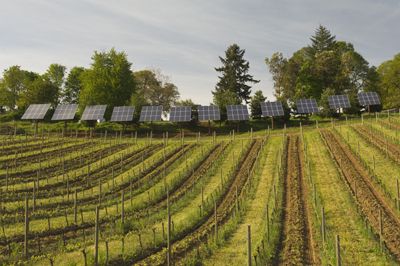Sunny Site Up


By Karl Klooster
If you’ve read anything about solar energy, you know its long-term benefits can be significant. Save energy. Save money. Save the earth. It’s a win-win-win all the way around.
However, initial investment is pricey. Not as much as it used to be, but still enough to give the average person pause before covering their rooftop with the high-tech, photovoltaic cells known as solar panels. What makes the installation of solar energy particularly appealing is federal rebates. Whether for home or business use, these incentives to install solar substantially shorten the break-even recovery time. Called feed-in tariff programs, they are designed to accelerate investment in renewable energy technologies.
The Oregon Public Utility Commission launched its feed-in tariff pilot program in July 2010 to test incentive pay for solar energy generation. Sun exposure being a factor, the program actually pays more for small systems in wetter counties than for medium systems in sunnier parts of the state.
Moshrek Sobhy of the OPUC said, “Midway through the four-year program, we appear to be finding more permanent pricing. We may not be exactly there, but we are getting close.”
Of course, cost should not be the sole consideration when it comes to the decision to replace or at least supplement conventional, fossil-based energy sources with alternative, renewable ones.
People who take the time to analyze the hard facts for themselves, instead of relying simply on a favorite information source that happens to fit one’s socio-political leanings, will likely find that 99 percent of the scientists are actually right.
The vast preponderance of empirical evidence points toward a future filled with ecological woes the likes of which mankind has never witnessed. But there are ways to substantially reduce the negative impact. Cutting fossil fuel consumption is one of the most important.
Certainly, other renewable energy alternatives besides solar should be considered. Geothermal and wind both quickly come to mind. But, for the time being, our old reliable sun seems to be the most viable.
Someday, perhaps in the not-so-distant future, mainstream attitudes may change to the point where alternative energy sources led by solar will, in fact, become the conventional ones.
Meanwhile, the Oregon wine industry continues to step up its commitment to solar energy. A statewide survey conducted by Oregon Wine Press elicits a single and singularly complimentary word: commendable.
The survey showed that several dozen wineries have already made substantial, long-term investments in solar arrays and many of them plan to increase their infrastructures over time.
One winery that won’t have to do that, however, is Tyee Wine Cellars of Corvallis. The system, an 84-panel, 14.7-kWh (kilowatt hours) array installed in the spring of 2009, provides all their electric power needs.
That’s right. Tyee is 100-percent solar powered. In fact, winemaker Merrilee Buchanan Benson reported that they generate more power per year than they need. The excess is sent back to the grid and donated to families in the area.
Domaine Drouhin Oregon was among the first in Oregon to install a large solar array. The Dundee Hills winery’s output of 84 kWh accounts for a significant portion of their power usage.
Not far away, Sokol Blosser Winery, an industry leader in sustainability, has a 24-kWh array that generates 20 percent of their overall energy needs. The system has been very reliable with only occasional maintenance over the past six years.
Ivy Hover of Left Coast Cellars enthusiastically responded, “We use solar!” Just north of Rickreall, the winery’s 83 kWh on two arrays fills approximately 80 percent of their electricity needs.
“Our solar panels were installed in 2008 with assistance from the largest USDA renewable energy grant in the state of Oregon that year,” Hover said. “The 21-kWh ground-mounted solar panel by our Latitude 45 Vineyard provides 100 percent of the power for our guest cottage, front gate and all the estate irrigation needs of our vineyards and extensive landscaping.
“In the winery, our 62- kWh roof-mounted array generates the majority of our electricity for the estate,” Hover continued. “Our power bill for the ground array is $11, solely for taxes and grid access fees. Annually, any excess electrical production is credited to low income housing.
“The electric bill for our winery and tasting room dropped from $1,200 monthly to $300 to $400. So far, our solar installation has been trouble-free and required no maintenance. It is backed by a 25-year equipment warranty.”
Farther north in the Chehalem Mountains, Ponzi Vineyards assembled their 46.4-kWh array just this June, so has limited experience mixed with high hopes. Marketing manager Laurel Dent said the winery is participating in a feed-in tariff program, which has proved to be a factor in bringing several Oregon wineries into the solar fold.
Under a similar program, Susan Teppola, owner of Laurel Ridge Winery said they are sharing the benefit with the installer.
She said the panels are rated at 126 kWh, which would make it the Oregon wine industry’s largest system. It currently provides 100 percent of the winery’s needs, as well as her nearby house and outbuildings. It even has an electric car charger.
Bethel Heights Vineyard at the southern end of the Eola Hills put in a 60-kWh array, consisting of about 250 panels, in September of 2010. Winery co-founder Ted Casteel said, “Since we aggregated the five meters on our property, it has been producing all the electricity required for our business, including the winery, two homes and our irrigation system.
We only pay for the basic service charge on the meters, which amounts to about $60 per month.”
Other sizable arrays include Wine Country Farms’ recently installed panels. “We are just now hooking into PGE,” owner Joan Davenport said. “Total output is 86.4 kWh.”
Torii Mor has a 47.5-kWh system on the roof of the winery, which Monique Bailey said supplies 12 percent of their power needs.
As part of a comprehensive sustainability program for NW Wine Company’s new facility in Dundee, solar panels were installed on the roof when it was completed last fall.
Marketing manager Lauren Gallus said, “Our system size is 46.2 kWh. During the first year, our system provided just over 18 percent of our electricity.”
Smaller installations can work well for smaller wineries, as well. Phil Kramer at AlexEli Vineyard in the eastern Willamette Valley said they installed a 9.9-kWh unit last spring, and it accounts for roughly 50 percent of their usage.
At Cowhorn Vineyard in Jacksonville, Bill Steele said they installed a 3.29-kWh grid tie system this May. I’m not sure if the reduction was all due to the solar system, he said. But our average daily cost went from $4.13 per day last year to $1.56 this year.”
There’s more annual sunshine in Central Oregon and Maragas Winery takes advantage of it. Their 14-kWh array accounts for about 35 percent of annual power usage.
High in the Coastal foothills just southwest of Gaston, Kramer Vineyards had its 5-kWh system operational in June of 2008.
Owner Trudy Kramer said the array generated 10 percent higher output than projected and they want to add more panels. They’re also considering a windmill for those dark winter days.
At nearby Elk Cove Vineyards, controller Robert Verant said, “We installed a solar system in September 2008. It’s rated at 38.8 kWh, but we have seen just over 40 kWh of energy production annually, so it has exceeded estimates.
“The arrays offset 35 to 40 percent of our annual usage,” he added. “We save about $15,000 annually in energy costs with very little maintenance required. Overall, our experience has been excellent; and thanks to tax credits, the system has already paid for itself and has started creating real returns for the winery.”
Felix Jones at Chateau Bianca said, “We have photovoltaic cells on the roof of our main building. Our system has 10 kWh cumulatively. Output varies with the time of year and light exposure. But we estimate that the PV array is offsetting about 85 percent of our total power usage right now.”
Many respondents not currently using solar panels either mentioned upcoming plans to install them or the desire to do so when the time is right. Those who did not intend to install solar were primarily boutique operations.
Not one person replying to this survey expressed any negative feelings about the usage of solar, reflecting the knowledge that, even here in gray Western Oregon, it still works well.
The one exception, if you could call it that, was Earl Jones of Abacela Vineyards in Roseburg. His 4,000-plus-square-foot Vine & Wine Center is a passive solar structure, i.e. no panels.
“The building utilizes a geothermal-based system and controls the interior room temperature by hydronic radiant heat of the floors in winter and air chilling in summer,” Jones said.
That would seem to be the latest development in regard to the wine industry’s up front and energetic relationship with our G2 Yellow Day Star, known as the sun.
Scientists say our sun has been around for 4.57 billion years. And the best estimates say it will keep shining for another 5 billion or so before destabilizing. Then it will, in effect, consume itself and almost everything else in the solar system, including us, whatever we may be by then.
In the meantime, let’s focus our concerns on the next several decades, rather than the next several thousand millennia.










